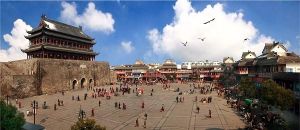Anhui Food
Introduce
Anhui cuisine is one of the eight major cuisines in China. Anhui cuisine originated in the Qin and Han dynasties, prospered in the Tang and Song dynasties, and flourished in the Ming and Qing dynasties. It reached its peak in the middle and late Qing dynasty. Anhui cuisine is the local characteristic of Hui Zhou, and its unique geographical and cultural environment gives it its unique taste. Due to the rise of Anhui merchants in Ming and Qing dynasties, this local flavor gradually entered the local shops and spread in Jiangsu, Zhejiang, Jiangxi, Fujian, Shanghai and Hubei as well as the middle and lower reaches of the Yangtze river. With extensive influence, it once ranked first among the eight major cuisines in the Ming and Qing dynasties.
Origin
Anhui cuisine originated in Shexian county (ancient Huizhou), the capital city of Huizhou. It originated in Tang and Song dynasties, flourished in Ming and qing dynasties, and developed further in Jixi during the republic of China. Jixi county, Xuancheng city, Anhui province has been awarded the title of hometown of Anhui cuisine. The international food culture festival of Anhui cuisine is held every year.
Culture
The formation of Anhui cuisine is closely related to the unique geographical environment, cultural environment and dietary customs of Huizhou in ancient Jiangnan, providing an inexhaustible supply of raw materials for Anhui cuisine. Unique conditions have become a strong material guarantee for the development of Anhui cuisine. At the same time, various customs and rituals and seasonal activities in Huizhou have also strongly promoted the formation and development of Anhui cuisine. The heyday of Anhui cuisine was the period when hui merchants dominated China. To some extent, Huizhou merchants have made great contributions to the spread and development of Anhui cuisine.
Characteristics
Anhui cuisine is good at cooking, stewing and steaming, with heavy oil, heavy color and heavy fire. While fried dishes are less. First of all, It become outstanding because of local draw materials. Secondly, it makes good use of the heat. Thirdly, it is good at stewing and strikes a balance in the flavor. Fourth, pay attention to natural and eating regimen. Anhui cuisine inherits the tradition of the same origin of Chinese medicine and food. Keeping good health by eating food, which is a major feature of Anhui cuisine.
History
"Hui" is the abbreviation of Huizhou. "Anhui cuisine" gets its name from Huizhou. It prospers because of the rise of Huizhou merchants and weakens because of their decline. The prosperity of Huizhou merchants promoted the development of catering industry in their hometown, which not only raised the level of Anhui cuisine and made it a necessity for banquets and social gatherings, but also promoted Anhui cuisine restaurants all over the country.
Cooking skills
There are more than 50 kinds of cooking techniques commonly used in Anhui cuisine in 20 categories, among which the most representative hui style features are sliding, stewed and fuming.
Development
Hui merchants will set up a table of hometown dishes for business, social intercourse or friends' party to show their respect to the distinguished guests.
Huizhou merchants spread all over the world, so hui restaurant began to appear, promoting the development of Anhui cuisine system.
Famous Food
| English | Traditional Chinese | Simplified Chinese | Pinyin | Description |
|---|---|---|---|---|
| Bagongshan Stinky Tofu | 八公山臭豆腐 | 八公山臭豆腐 | bāgōngshān chòu dòufǔ | Also known as "four seasons tofu", is a traditional local snack in Huainan, Anhui. |
| Egg dumplings | 農家蛋餃 | 农家蛋饺 | nóngjiā dàn jiǎo | These dumplings, usually associated with rural cooking, use thin sheets of egg instead of flour for the wrapping. Egg dumplings traditionally use pork as a filling. In preparation, a ladle is lightly coated with oil and heated, well beaten eggs are spooned into the ladle and cooked until the mixture forms a dumpling wrapper. The pork filling is then spooned into the egg wrapping and the entire dumpling steamed. It is often served with soy sauce. |
| Li Hongzhang Chop Suey | 李鴻章雜碎 | 李鸿章杂碎 | Lǐ Hóngzhāng zásuì | A popular dish named after Li Hongzhang a prominent Qing dynasty statesman from Anhui Province. The dish, a complex soup, is somewhat salty with a taste of sweetness. Many ingredients are used in the soup but the most common ones include fish, squid, bamboo, dry bean curd, chicken, ham and assorted vegetables. |
| Luzhou roast duck | 廬州烤鴨 | 庐州烤鸭 | Lúzhōu kǎoyā | A popular dish from Hefei which first gained recognition when it was offered as tribute to the imperial court. While not as well known internationally as Peking duck, Luzhou roast duck has won awards and distinction within China. |
| Potato cellophane noodles | 紅薯粉絲 | 红薯粉丝 | hóngshǔ fěnsī | Sweet potato starch vermicelli. |
| Sanhe shrimp paste | 三河蝦糊 | 三河虾糊 | sānhé xiāhú | A regional dish that originated in Sanhe, Feixi County, but can now be found in Hefei. The dish's main components are rice flour and a regional species of small white shrimp. The shrimp are stir fried with leeks and soy sauce, while the rice flour is soaked in water and later added to the shrimp. The dish is brown in colour and tastes pleasantly salty. It is eaten with a spoon. |
| Steamed stone frog | 清蒸石蛙 | 清蒸石蛙 | Qīngzhēng shí wā | The dish has been proven to be rich in protein and other nutrients. |
| Wushan imperial goose | 吳山貢鵝 | 吴山贡鹅 | wúshān gòng'é | The history of Wushan imperial goose dates back to the Tang dynasty. The dish is lightly coloured and has a fragrant and salty taste. |
